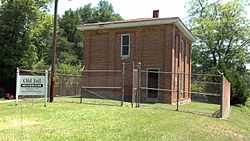Knoxville, the county seat, was a thriving community during the later part of the 1800’s. When the railroad came through Crawford County, it did not go through Knoxville, thus another community developed near the railroad.
In the beginning this community was called New Knoxville, but in 1890-91 the town of Roberta was incorporated and in 1910 the city of Roberta was incorporated. The boundaries were to extend 1200 yards in every direction from the present position of the monument. Since Mr. Hiram McCrary gave the land for the town, he was asked to name the town; he chose the name Roberta after his small daughter.
The first mayor was A. J. Danielly, and the first council consisted of J. W. Matthews, J. W. Melpass, Frank Danielly, W. W. Jordan, and Jonathon Wilder.
Because of the passenger service provided by the trains, Roberta became a thriving community catering to tourists. A few years later US 341 came through Roberta, taking tourists South to Florida, and Roberta became a booming tourist town for many years. But as the passenger service was discontinued by the railroad, and other highways opened, Roberta became less and less a tourist town, and more a quiet southern community.
In Knoxville, there are several buildings listed on the National Register of Historic Places, including the Crawford County Courthouse (1831) and the Crawford County Jail (1882). Included in Crawford County historic buildings is the Roberta Historic District in Historic District is listed.
There are 19 archaeological sites in the county that have been filed with the State Archeological Office. The sites include the Indian Agency Reserve on the banks of the Flint River and the Creek habitation area along the Flint River. Benjamin Hawkins, an Indian agent from 1794 to 1816, is buried on this site.
